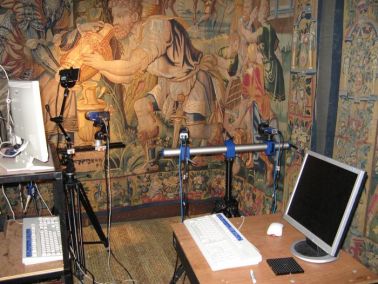LaVision’s StrainMaster DIC system applied to historic tapestry creep monitoring
Monday, 15. November 2010
Tapestry creep monitoring with LaVision's StrainMaster system
Image courtesy of Tapestry Monitoring Research Project, carried out by the Textile Conservation Centre and the School of Engineering Sciences at the University of Southampton
The three-year project was funded by AHRC, the Arts and Humanities Research Council, and began in January 2007. It aimed to enhance the long-term preservation of tapestries by monitoring the strain behaviour of them, simply and unobtrusively, in situ. The research set out to question whether tapestries are being pulled apart by their own weight, and also whether it is possible to identify incipient damage before it is visible to the naked eye. In the course of this project, two PhD students from the University of Southampton validated and developed the Digital Image Correlation technique, using the StrainMaster DIC system from LaVision. It could be shown, that there is a complex relationship between creep, the permanent deformation to a tapestry caused by hanging, and the damage caused by fatigue, or the constant expansion and contraction of fibres and yarns caused by fluctuations in relative humidity (RH). This research has demonstrated that it is possible to quantify the strain and to begin to gain a better understanding of the mechanisms causing damage. In addition the Digital Image Correlation technique generates colorful strain maps, which can be superimposed on the images of the tapestry, thereby providing an extremely useful tool for conservators, and for curators and other custodians, in explaining the way tapestries change. Please refer to www.tapestry-strain.org.uk to read more interesting details about this Tapestry Monitoring Research Project. You will also find several publications linked to this topic here


